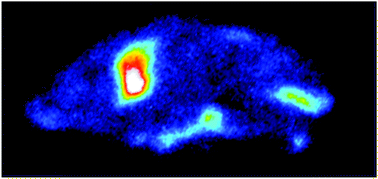当前位置:
X-MOL 学术
›
Metallomics
›
论文详情
Our official English website, www.x-mol.net, welcomes your feedback! (Note: you will need to create a separate account there.)
Studies of copper trafficking in a mouse model of Alzheimer's disease by positron emission tomography: comparison of 64Cu acetate and 64CuGTSM
Metallomics ( IF 3.4 ) Pub Date : 2017-10-18 00:00:00 , DOI: 10.1039/c7mt00227k Erica M. Andreozzi 1, 2, 3, 4, 5 , Julia Baguña Torres 1, 2, 3, 4, 5 , Kavitha Sunassee 1, 2, 3, 4, 5 , Joel Dunn 1, 2, 3, 4, 5 , Simon Walker-Samuel 4, 5, 6, 7 , Istvan Szanda 1, 2, 3, 4, 5 , Philip J. Blower 1, 2, 3, 4, 5
Metallomics ( IF 3.4 ) Pub Date : 2017-10-18 00:00:00 , DOI: 10.1039/c7mt00227k Erica M. Andreozzi 1, 2, 3, 4, 5 , Julia Baguña Torres 1, 2, 3, 4, 5 , Kavitha Sunassee 1, 2, 3, 4, 5 , Joel Dunn 1, 2, 3, 4, 5 , Simon Walker-Samuel 4, 5, 6, 7 , Istvan Szanda 1, 2, 3, 4, 5 , Philip J. Blower 1, 2, 3, 4, 5
Affiliation

|
Alzheimer's disease can involve brain copper dyshomeostasis. We aimed to determine the effect of AD-like pathology on 64Cu trafficking in mice, using positron emission tomography (PET imaging), during 24 hours after intravenous administration of ionic 64Cu (Cu(II) acetate) and 64Cu-GTSM (GTSMH2 = glyoxalbis(thiosemicarbazone)). Copper trafficking was evaluated in 6–8-month-old and 13–15 month-old TASTPM transgenic and wild-type mice, by imaging 0–30 min and 24–25 h after intravenous administration of 64Cu tracer. Regional 64Cu distribution in brains was compared by ex vivo autoradiography to that of amyloid-β plaque. 64Cu-acetate showed uptake in, and excretion through, liver and kidneys. There was minimal uptake in other tissues by 30 minutes, and little further change after 24 h. Radioactivity within brain was focussed in and around the ventricles and was significantly greater in younger mice. 64CuGTSM was taken up in all tissues by 30 min, remaining high in brain but clearing substantially from other tissues by 24 h. Distribution in brain was not localised to specific regions. TASTPM mice showed no major changes in global or regional 64Cu brain uptake compared to wildtype after administration of 64Cu acetate (unlike 64Cu-GTSM) but efflux of 64Cu from brain by 24 h was slightly greater in 6–8 month-old TASTPM mice than in wildtype controls. Changes in copper trafficking associated with Alzheimer's-like pathology after administration of ionic 64Cu are minor compared to those observed after administration of 64Cu-GTSM. PET imaging with 64Cu could help understand changes in brain copper dynamics in AD and underpin new clinical diagnostic imaging methods.
中文翻译:

用正电子发射断层扫描技术研究阿尔茨海默氏病小鼠模型中的铜运输:64 Cu乙酸盐和64 CuGTSM的比较
阿尔茨海默氏病可能涉及脑铜动态异常。我们的目的是确定AD样病理的效果64在小鼠中的Cu贩卖,使用正电子发射断层摄影(PET成像)中,在离子的静脉内给药后24小时64的Cu(铜(II)乙酸盐)和64的Cu-GTSM( GTSMH 2 =乙二醛(硫代半脲)。通过静脉注射64 Cu示踪剂后0-30分钟和24-25 h成像,对6-8个月大和13-15个月大的TASTPM转基因和野生型小鼠中的铜运输进行了评估。通过离体放射自显影将淀粉在脑中的区域64 Cu分布与淀粉样蛋白β斑进行比较。64醋酸铜显示肝脏和肾脏吸收并通过肝脏和肾脏排泄。到30分钟时,其他组织的吸收最少,并且24小时后几乎没有进一步变化。脑内的放射性集中在脑室及其周围,在年轻的小鼠中明显更高。到30分钟时,所有组织中都吸收了64 CuGTSM,在大脑中保持高水平,但到24小时时,基本上已从其他组织清除。大脑中的分布并不局限于特定区域。与野生型相比,TASTPM小鼠在施用64 Cu乙酸酯后(与64 Cu-GTSM不同)与野生型相比,在全局或区域性64 Cu脑摄取中无重大变化,但流出64在6-8个月大的TASTPM小鼠中,到24小时时来自大脑的铜含量比野生型对照中的稍高。与施用64 Cu-GTSM后观察到的那些相比,与施用离子64 Cu后有关的与阿尔茨海默氏样病理相关的铜运输的变化较小。采用64 Cu的PET成像可以帮助了解AD中脑铜动力学的变化,并为新的临床诊断成像方法提供基础。
更新日期:2017-10-24
中文翻译:

用正电子发射断层扫描技术研究阿尔茨海默氏病小鼠模型中的铜运输:64 Cu乙酸盐和64 CuGTSM的比较
阿尔茨海默氏病可能涉及脑铜动态异常。我们的目的是确定AD样病理的效果64在小鼠中的Cu贩卖,使用正电子发射断层摄影(PET成像)中,在离子的静脉内给药后24小时64的Cu(铜(II)乙酸盐)和64的Cu-GTSM( GTSMH 2 =乙二醛(硫代半脲)。通过静脉注射64 Cu示踪剂后0-30分钟和24-25 h成像,对6-8个月大和13-15个月大的TASTPM转基因和野生型小鼠中的铜运输进行了评估。通过离体放射自显影将淀粉在脑中的区域64 Cu分布与淀粉样蛋白β斑进行比较。64醋酸铜显示肝脏和肾脏吸收并通过肝脏和肾脏排泄。到30分钟时,其他组织的吸收最少,并且24小时后几乎没有进一步变化。脑内的放射性集中在脑室及其周围,在年轻的小鼠中明显更高。到30分钟时,所有组织中都吸收了64 CuGTSM,在大脑中保持高水平,但到24小时时,基本上已从其他组织清除。大脑中的分布并不局限于特定区域。与野生型相比,TASTPM小鼠在施用64 Cu乙酸酯后(与64 Cu-GTSM不同)与野生型相比,在全局或区域性64 Cu脑摄取中无重大变化,但流出64在6-8个月大的TASTPM小鼠中,到24小时时来自大脑的铜含量比野生型对照中的稍高。与施用64 Cu-GTSM后观察到的那些相比,与施用离子64 Cu后有关的与阿尔茨海默氏样病理相关的铜运输的变化较小。采用64 Cu的PET成像可以帮助了解AD中脑铜动力学的变化,并为新的临床诊断成像方法提供基础。


























 京公网安备 11010802027423号
京公网安备 11010802027423号